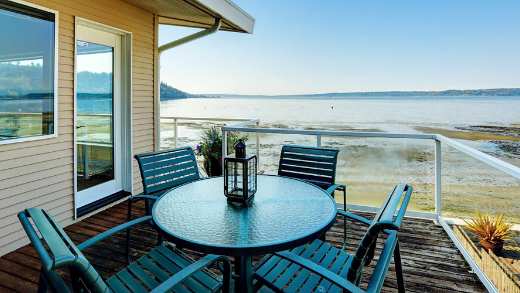Your home is probably the most expensive purchase you'll ever make, and home insurance gives you peace of mind that if something goes wrong, you’ll be able to fix it. But it’s important to understand what your policy will and won’t cover.
There are two types of home insurance: buildings and contents cover. Naturally, buildings insurance covers the building itself: the actual structure of your home, or the roof, walls, and windows and other permanent parts of the house like your kitchen and bathroom.
Contents insurance covers the things inside your home, like your television and jewellery.
You can choose to have either type of home insurance without the other, but if you’re a homeowner, you probably have both. If you’re a tenant, buildings insurance will be your landlord’s responsibility.
Home insurance: what does it usually cover?
Home insurance is designed to protect your house from big events like fires, storms and floods. Any damage caused by a significant event like these would be covered – however, normal wear and tear isn’t.
So, for example, imagine there’s a major storm in your area. If your home is damaged due to high winds, but your roof needed maintenance work, it’s not covered because the winds would have highlighted the existing damage.
But, if the high winds made a tree fall on your roof, then your roof repairs would be covered.
You can also cover your building for accidental damage, like putting your foot through the ceiling or drilling into a water pipe. This is typically an optional extra to your policy – meaning you may need to pay a higher premium for this cover.
Similarly, your contents insurance would normally pay if, for example, your television was damaged by a water leak, but not if it just stopped working. This would be considered a ‘breakdown’.
You can also cover items such as your television if you accidentally knock it over, but this would be considered accidental damage. As with buildings, this is typically an add-on to your policy – meaning you will pay a higher premium for this cover.
Single Item Limits
While your contents insurance will include most things in your home, like a phone or painting, most policies have a Single Item Limit for items considered valuable.
A Single Item Limit is that maximum an insurer will pay for one item. If the value exceeds a set value, then you need to register the item individually. Each insurer will have a different list of things that are considered valuable, but they usually include jewellery and watches.
Your belongings can also be covered when you’re away from home. For example, your mobile phone and jewellery can be covered if it was damaged or stolen while you were out and about. You would normally need to select and pay extra for this cover.
There is often a Single Item Limit for these items too, so you may have to list them if they are over a certain value likely between £1,500-2,000. If you have anything more valuable than that, let your insurer know so it can be added to the policy, though this may affect your premium.
Add ons
There are a few more things you may want to include on your policy – these may be available as add-ons:
Home emergency cover
This covers all kinds of emergencies, including broken locks, a breakdown of your heating system, emergency fixes to burst pipes and roofs and clearing blocked drains. If you can’t stay in your home while the problem is fixed, there’s cover for alternative accommodation too.
Legal cover
You never know when you might need a lawyer. This cover isn’t just limited to house-related reasons – you might need a lawyer for personal injury or medical negligence, as well as property disputes. Check your policy booklet, but a range of services are generally included.
Bicycle cover
When your bike is at home, it’s probably covered under a contents insurance policy. But you didn’t buy a bike just to keep it in the shed, did you? With Aviva Home Insurance, we offer extra cover for bikes used by you and your family anywhere in the world. Just select your own level of cover between £300 and £3,500.
What’s usually not covered
All insurance policies have exclusions, and home insurance policies are no different. In addition to general wear and tear, and the optional extras like accidental damage cover, home insurance policies have some common exclusions. Examples of these are:
- Frost damage
- Storm damage to gates, fences, and hedges
- Any deliberate damage caused by a member of your household
- Damage caused by birds, insects, and other pests
- Damage caused by pets
Another expensive part of your home that may break, but isn’t covered by a standard home insurance policy, is your boiler. If you’re a homeowner, you may want to look into boiler cover.
And remember – many insurance policies are invalidated if your property is left unoccupied for more than 30 days. This is because the risk of damage and/or theft goes way up when homes are empty for that long.
Do I need home insurance?
Could you afford to rebuild your home if there were major damage from a fire? What about replacing all of your belongings if you were the victim of theft? Probably not. That’s why many people decide to get buildings and contents cover.
Here are the most common claims Footnote [1] people make:
- Accidental Damage – 107,539
- Escape of Water – 61,932
- Storm – 29,741
- Other – 29,039
- Theft – 27,801
If you’re looking to keep your premium down, you can select a higher excess. But keep in mind the cost of whatever items you would need to replace if something was lost, broken, or stolen. A good example of this would be your mobile phone. Repairing or replacing it might cost about the same as your excess, so you may choose not to claim.
You should also check that you need the level of cover you’ve purchased – for example, you may have legal cover through your bank already, so you don’t need to purchase it again with your home insurer. However, make sure to check that the level of cover you get is enough to meet your needs.
Finally, if you are getting both buildings and contents insurance, it usually pays to get them together, as most insurers offer a discount for combined cover. You’ll also avoid paying a separate excess for two policies, and if you have a claim which affects both policies, it will be easier if you are only dealing with one policy.




